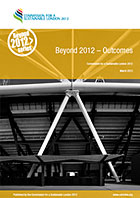The Commission for a Sustainable London 2012 has today published its Waste Report on the approach taken to waste management and infrastructure across the London 2012 programme
The report praises the work done by the ODA in recycling construction and demolition waste, and by LOCOG in planning for a zero-waste to landfill Games. Good progress is also being made to ensure that the dismantling phase after the Games does not become a ‘skip-fest’, with all waste going straight to landfill. Concerns remain about waste management in the areas surrounding the Olympic and Paralympic venues and the development of waste infrastructure in East London.
Shaun McCarthy, Chair of the Commission, said: “The good news is that the ODA and LOCOG are both working towards ambitious targets. If achieved, this ambition and dedication will make the 2012 Games an exemplar of how to run a sustainable event and will set brand-new green standards for future Games. Our concerns are that while all this good work is going on inside the venues, waste in the areas immediately surrounding the venues could be forgotten about. There needs to be a consistently high standard and this means more collaboration between stakeholders and organisers.”
Comments on waste progress
The ODA is exceeding its 90% reuse or recycling target for demolition waste. This is world-class progress and both its performance and experience have now become a construction industry benchmark. The ODA is meeting its construction waste target to divert 90% from landfill through reuse, recycling and recovery. The ODA is also on course to exceed its targets for recycled content; currently projecting to use 34% recycled materials by value in the construction of the venues; well above its 20% target.
LOCOG is responsible for the Games-time targets of zero waste to landfill and 70% of waste to be reused, recycled or composted rather than incinerated. The Commission is impressed with the drive and commitment of LOCOG officers in embedding zero waste principles throughout the organisation. These have included areas, such as press operations and on-site branding, which have barely been touched by waste minimisation concerns in past Games.
LOCOG also has a stretch target that 90% of materials arising during installation and deconstruction of temporary infrastructure are reused or recycled and is developing plans to address this. Their key challenge now is to ensure that all their commitments are effectively delivered in their entirety.
The Commission is concerned that there is a need for careful coordination and management of the Post-Games dismantling and transformation process to ensure that sustainability standards are maintained and that nothing is lost between different areas of responsibility. The Commission recommends that a target is set for the reuse of assets and materials for the dismantling and transformation phases.
A major challenge for the London Games is the standard of waste management outside the LOCOG-controlled venues. The Commission believes that ‘live sites’, where the public will gather to watch events on big screens, and the areas immediately surrounding the venues across the UK should achieve, as far as possible, the same high standards of waste management as the venues. To meet these standards, City Operations Teams across the country will have to start addressing these issues in the very near future.
London 2012 committed to the promise of the Games being ‘a catalyst for new waste management infrastructure in East London’. Efforts are being made in this direction but waste infrastructure development, particularly for organic waste, has been slow. The role of the London Waste and Recycling Board is to address the market failure in this area. There is potential to use organic waste from the Games to supply zero carbon heat and power to the new communities on the Olympic Park as well as the wider East London area, provided that the London Waste and Recycling Board continues to fund new projects.
This report and further information can be found in the reports section of the CSL website.
